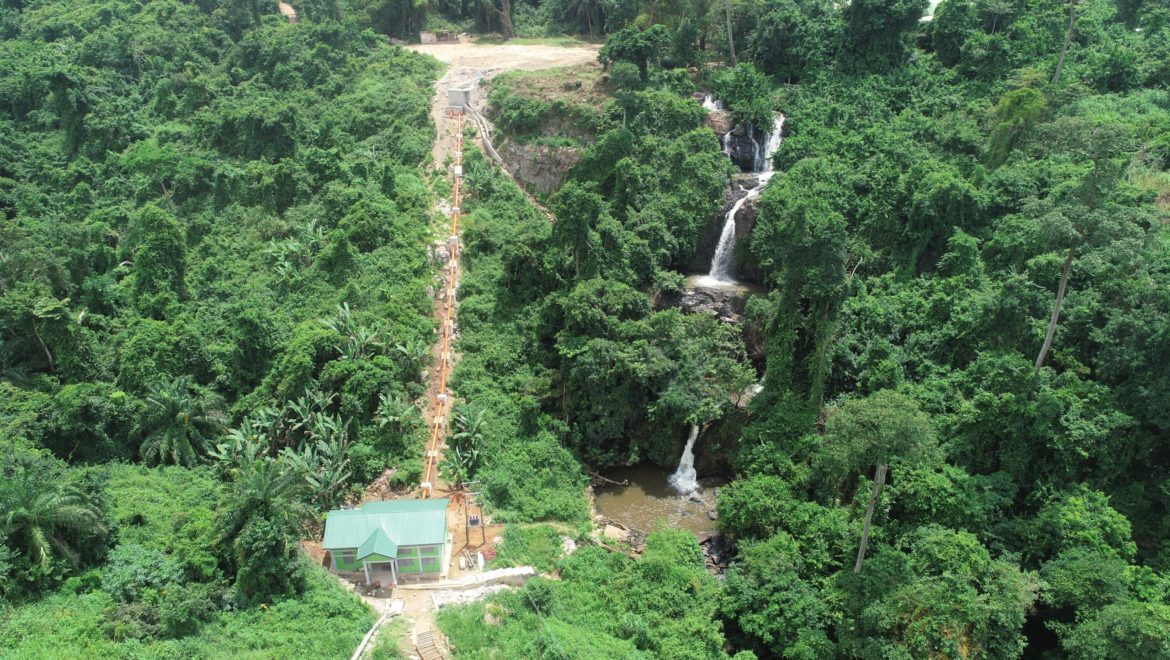The BPA commissioned Ghana’s first micro-hydropower plant known as the Tsatsadu Generating Station (TGS) under the Ministry of Energy’s Renewable Energy initiative. The Plant, situated on the Tsatsadu Waterfalls in the Hohoe District of the Volta Region, has a capacity of 45kW with the possibility of adding another 75kW capacity turbine in the future which will total 120kW upon completion.
The project, which cost USD400,000, was funded largely by internally generated funds from BPA and a contribution of USD80,000, provided by the UNDP/Energy Commission Renewable Energy Technology Transfer (RETT) project which received funding from the Danish Government to cover procurement of electromechanical equipment and technical support.
The TGS, which is a run-of-river scheme, does not require the formation of a reservoir. It consists of a concrete diversion weir, an intake structure, diversion channel, a forebay, steel penstock, a powerhouse and a transmission line and ties the electricity generated into the local distribution grid. The weir diverts part of the river flow through an intake channel into the diversion channel. The diverted water goes through a 300mm diameter penstock to the base of the hill where the powerhouse, which houses the turbines and the generator, is located. The water drives the turbines and flows out through the tailrace channel and into the downstream of the waterfall.
The construction of the TGS was undertaken with local expertise: thus, the young engineers of the Bui Power Authority (BPA). These engineers obtained the skill during the development of the 404MW Bui Generation Station, located in Bui. That experience came to bear on the construction of the 45kW TGS. The successful completion of the TGS creates the enabling environment for the transfer of acquired knowledge in the areas of design, development and operation of Small-Scale Hydro Power Plants. The objective is to transfer this knowledge to tertiary students, and industry players as a whole, in the quest to develop the other potential sites across Ghana. Ghana has abundant natural resources and features that support hydropower development. These include micro, mini, small and medium plants. Tini Waterfalls, Wli Waterfalls, Kintampo Waterfalls, Fuller Waterfalls, Pwalugu (60 MW), Juale (90 MW), Daboya (40 MW), Hemang (60 MW), Koulbi (62MW) and Tanoso (86MW) remain undeveloped. The Government of Ghana through its Renewable Energy Master Plan intents to develop these sites for power generation and irrigation.
Project Background
The Ministry of Energy in 2005 entered into a Memorandum of Understanding with the United Nations Industrial Development Organization (UNIDO) and International Network on Small Hydro Power of China (IN-SHP) to undertake studies to develop the existing small hydro power potentials in the country. The Tsatsadu Waterfalls, located at Alavanyo Abehenease in the Hohoe District of the Volta Region, was selected to be developed as a pilot project. UNIDO subsequently donated a 30kW generator and Turgo Turbine with associated electromechanical equipment for the project. The Ministry of Energy appointed the Bui Power Authority in 2016 to develop the Tsatsadu Micro Hydropower Project on its behalf. BPA then reviewed all available information on the project. This included site assessment surveys, detailed topographical surveys and the development of engineering drawings for the project.
The electromechanical equipment donated by UNIDO were retrieved from the Volta River Authority (VRA) and serviced. The project, which was initially designed as a 30kW stand-alone system was upgraded to a 45kW grid-connection system. A new 45kW capacity Asynchronous generator and new load controller were therefore procured to replace the existing 30kW generator and load controller.
Green Source of Power Generation
The development of the TGS did not have any adverse impact on the environment. Since there will be no impoundment or reservoir formation, trees will not be submerged and consequently no methane gas will be emitted. As a hydro scheme, its energy source is green and has no carbon emissions. Also, a reforestation programme implemented at the project site seeks to restore the vegetation in order to protect the river’s shoreline against siltation, sedimentation, erosion, nitrogen and phosphates loading. It is envisioned that the trees planted, and the forest being conserved, will contribute to climate change adaptation and building climate resilience which have direct impact on the hydropower generation.
Tourism Potential
The micro-hydro plant, which is the first of its kind in Ghana, will draw academia, tourists, students and people from all walks of life to visit the plant. It will serve, among other things, as a practical tutorial plant for engineering students across the country and the West African sub-region. The Hohoe Municipal Assembly is also expected to benefit from the TGS as an addition to its tourists’ products within the enclave.

